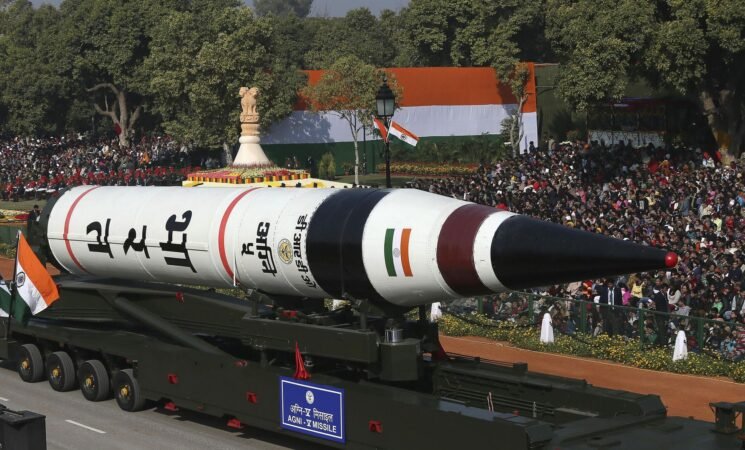18 July 2025, NIICE Commentary 11488
Anurag Paul
The world exploded into the nuclear age on 16th July 1945 when the US tested its Trinity bombs, and as the US-inflicted ‘doomsday clock’ completes its oscillations on Hiroshima and Nagasaki, ‘a few people laughed, a few people cried, most people were silent,’ said Robert Oppenheimer- the father of nuclear bombs. Since the massacre in Japan, one after another, the winners of World War II materialized their nuclear arms in much of a satirical fashion, and when the Asian dragon, China, realized its nuclear potential in 1964, it was time for India to accept its nuclear destiny.
India, since its independence, has been a consistent opponent of Nuclear weapons. Jawaharlal Nehru, the first prime minister of India and in charge of the Department of Atomic Energy, stated on many occasions that India had nothing to do with the atom bomb and she would like to use nuclear energy for peaceful purposes only. In 1961, supporting the Swedish resolution to the UN secretary general, India demanded the prevention of the dissemination of nuclear weapons and proposed restrictions on non-nuclear states regarding the manufacture of nuclear weapons or acquiring them from other states. However, the 1962 and 1965 wars followed by China gaining nuclear might led Lal Bahadur Shastri to search for an external nuclear security guarantee from both United States and the Soviet Union, but came up empty; the US relationship with Pakistan precluded an extended nuclear umbrella, while the Soviet Union remained ambivalent about extending any such guarantees and professed neutrality in any potential India–China conflict. Furthermore, the diverging interests of the superpowers and India on the 1968 Nuclear Non-Proliferation Treaty (NPT)—of which India was initially a vocal proponent owing to its purported provisions on disarmament—would ultimately find India as a non-signatory due to the inequities of the treaty that amounted to what Jaswant Singh would later term ‘nuclear apartheid’, as only a select club of elites would be able to have nuclear weapons. This forced India into a position of nuclear self-reliance.
Facing threats from China and persistent conflict with Pakistan, Indira Gandhi continued to hedge about the application of India’s nuclear power in deterrence, continuing to allow the Atomic Energy Commission (AEC) to lay the groundwork for nuclear explosions, which materialised in 1974 in Pokhran as ‘Smiling Buddha’. Remarkably, after the Peaceful Nuclear Explosion (PNE), India’s nuclear weapons programme went almost entirely dormant for nearly a decade and stirred only in 1979 in response to intelligence about Pakistan’s nuclear development, which accelerated following A.Q. Khan’s stealing of centrifuge technology from the Netherlands and a possible clandestine China-Pakistan agreement in 1976. China transferred fissile material, missile production facilities, and uranium enrichment equipment to Pakistan. Additionally, in Pakistan, nuclear control fell into the hands of the military as Zulfikar Ali Bhutto was replaced by Zia-ul-Haq, causing further anxiety in India.
At the same time in 1974, the Nuclear Suppliers Group (NSG) was established without India, the NPT was indefinitely extended after 1995, and another Comprehensive Test Ban Treaty (CTBT) came into place in 1996; further alienating India from the global nuclear affairs. Having no other options or aid in the face of demonic neighbours, India embarks on the path of gaining nuclear capability. On 11 May 1998, Operation Shakti was initiated with the detonation of one fusion and two fission bombs under the guidance of Dr. Abdul Kalam. These nuclear tests by Pakistan, as Chagai-I, and India as Pokhran-II, resulted in United Nations Security Council Resolution 1172 and economic sanctions from Western superpowers. By 1998, India was a nuclear power, but the aim was to deter possible attacks and not to be a tyrannical power. To rid South East Asia of fearing possible attack and to establish itself as a responsible nuclear power, India adopted the Nuclear Doctrine in 2003, built around the concept of ‘credible minimum deterrence’, ‘non-use of nuclear weapons against non-nuclear states’ and a ‘no first use’ posture. Consequently, India follows a policy of ‘deterrence by punishment’ through a ‘counter value’ targeting strategy aimed at inflicting unacceptable damage in the event of a major attack against India, or Indian forces anywhere. India believes that nuclear weapons are political weapons and not weapons of warfighting: their sole purpose is to deter the use of nuclear weapons and the threat thereof. Thus, continues to be a reluctant nuclear power being inspired by Gandhian modules of pacifism and non-violence. Such commitments not only brought South Asia to peace by establishing India as the region's net security provider but also ushered in a new phase in Indo-US relations via the 123 Civil Nuclear deal of 2008.
Although India has reason to celebrate over the US-backed global recognition of its status as a responsible nuclear weapons power, it also has reason to worry about nuclear proliferation, particularly about China and Pakistan. China is a known proliferator of nuclear weapons technology to Pakistan, and Pakistan is a known proliferator to North Korea, Iran, and Libya. Following the US-India nuclear deal, China made known a similar deal between itself and Pakistan for the transfer of civilian nuclear technology, about which India, however concerned, could hardly complain. Indeed, this development may encourage some in Pakistan to pursue a 'sub-conventional war that Delhi is yet to find effective ways to cope with'. In an all-out war, damaging to both, India, given its weight and assets, would certainly prevail. But in a controlled conflict, Pakistan may calculate that it can fight India to a draw or rely on its international friends to rescue it, should the tide turn against it decisively. China’s stance on India’s membership in the Nuclear Suppliers Group (NSG) raises a further point of concern. Although China consented to the 2008 NSG waiver that allowed India to participate in the peaceful trade of nuclear energy technologies, Beijing has reiterated that India’s admission to the group is impermissible. As China modernises its nuclear arsenal, the shift towards more offensive posturing is not entirely unlikely.
With the proliferation of nuclear weapons in states like North Korea, the breakdown of international agreements such as the INF treaty, coupled with China’s disinterest in engaging with new disarmament measures with the United States and Russia, the concerns about potential nuclear escalations or a new arms race may not be completely unwarranted. As more nuclear-armed states expand their nuclear capabilities and animosities rise between countries, whether nuclear or non-nuclear, the likelihood of both horizontal and vertical proliferation increases. China’s nuclear programme will play a key role in the future of the world nuclear order, and whether global disarmament could become a reality. To ensure deterrence against nuclear threats, India should continue to build up its triad of land, air, and sea-based missiles, while modernising its older land missile systems. The nuclear command and control system should be hardened against cyber-attacks. India also needs to gradually start building up a missile defence system to protect major cities. Capacity should be created for dealing with the threat of Weapons of Mass Destruction by state and non-state actors.
Anurag Paul is a Research Intern at NIICE and is currently pursuing his Master od Arts in Political Science at Indira Gandhi National Open University, India.

